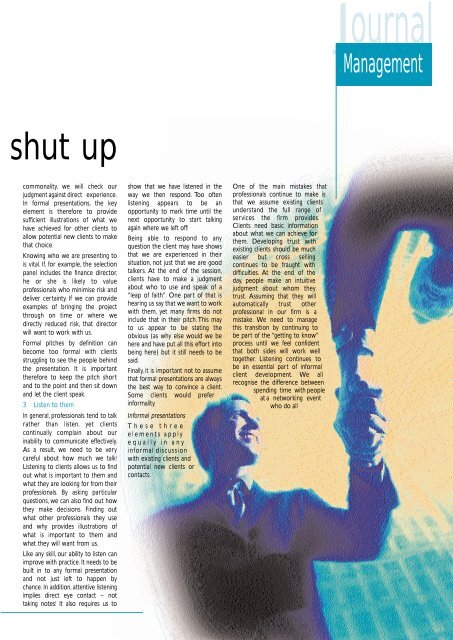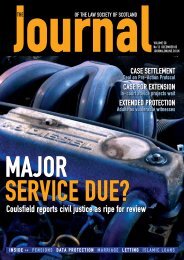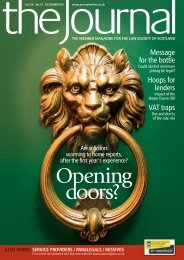OF THE LAW SOCIETY OF SCOTLAND - The Journal Online
OF THE LAW SOCIETY OF SCOTLAND - The Journal Online
OF THE LAW SOCIETY OF SCOTLAND - The Journal Online
Create successful ePaper yourself
Turn your PDF publications into a flip-book with our unique Google optimized e-Paper software.
shut up<br />
commonality, we will check our<br />
judgment against direct experience.<br />
In formal presentations, the key<br />
element is therefore to provide<br />
sufficient illustrations of what we<br />
have achieved for other clients to<br />
allow potential new clients to make<br />
that choice.<br />
Knowing who we are presenting to<br />
is vital. If, for example, the selection<br />
panel includes the finance director,<br />
he or she is likely to value<br />
professionals who minimise risk and<br />
deliver certainty. If we can provide<br />
examples of bringing the project<br />
through on time or where we<br />
directly reduced risk, that director<br />
will want to work with us.<br />
Formal pitches by definition can<br />
become too formal with clients<br />
struggling to see the people behind<br />
the presentation. It is important<br />
therefore to keep the pitch short<br />
and to the point and then sit down<br />
and let the client speak.<br />
3 Listen to them<br />
In general, professionals tend to talk<br />
rather than listen, yet clients<br />
continually complain about our<br />
inability to communicate effectively.<br />
As a result, we need to be very<br />
careful about how much we talk!<br />
Listening to clients allows us to find<br />
out what is important to them and<br />
what they are looking for from their<br />
professionals. By asking particular<br />
questions, we can also find out how<br />
they make decisions. Finding out<br />
what other professionals they use<br />
and why provides illustrations of<br />
what is important to them and<br />
what they will want from us.<br />
Like any skill, our ability to listen can<br />
improve with practice. It needs to be<br />
built in to any formal presentation<br />
and not just left to happen by<br />
chance. In addition, attentive listening<br />
implies direct eye contact – not<br />
taking notes! It also requires us to<br />
show that we have listened in the<br />
way we then respond. Too often<br />
listening appears to be an<br />
opportunity to mark time until the<br />
next opportunity to start talking<br />
again where we left off!<br />
Being able to respond to any<br />
question the client may have shows<br />
that we are experienced in their<br />
situation, not just that we are good<br />
talkers. At the end of the session,<br />
clients have to make a judgment<br />
about who to use and speak of a<br />
“leap of faith”. One part of that is<br />
hearing us say that we want to work<br />
with them, yet many firms do not<br />
include that in their pitch. This may<br />
to us appear to be stating the<br />
obvious (as why else would we be<br />
here and have put all this effort into<br />
being here) but it still needs to be<br />
said.<br />
Finally, it is important not to assume<br />
that formal presentations are always<br />
the best way to convince a client.<br />
Some clients would prefer<br />
informality.<br />
Informal presentations<br />
<strong>The</strong>se three<br />
elements apply<br />
equally in any<br />
informal discussion<br />
with existing clients and<br />
potential new clients or<br />
contacts.<br />
One of the main mistakes that<br />
professionals continue to make is<br />
that we assume existing clients<br />
understand the full range of<br />
services the firm provides.<br />
Clients need basic information<br />
about what we can achieve for<br />
them. Developing trust with<br />
existing clients should be much<br />
easier but cross selling<br />
continues to be fraught with<br />
difficulties. At the end of the<br />
day, people make an intuitive<br />
judgment about whom they<br />
trust. Assuming that they will<br />
automatically trust other<br />
professional in our firm is a<br />
mistake. We need to manage<br />
this transition by continuing to<br />
be part of the “getting to know”<br />
process until we feel confident<br />
that both sides will work well<br />
together. Listening continues to<br />
be an essential part of informal<br />
client development. We all<br />
recognise the difference between<br />
spending time with people<br />
at a networking event<br />
who do all<br />
<strong>Journal</strong><br />
Management










